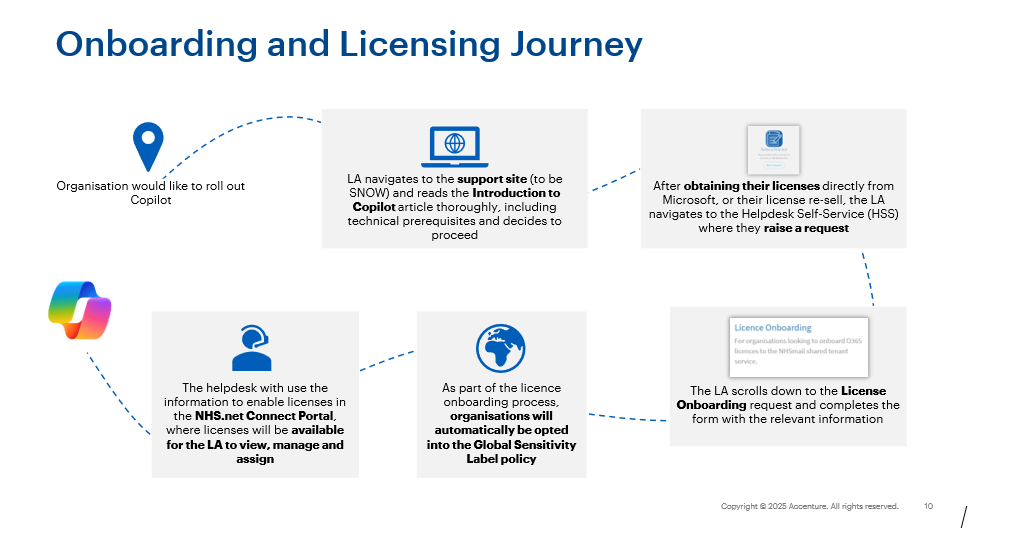1. M365 Copilot Prerequisites & Onboarding Process
This article provides a summary of the prerequisites that NHS organisations must have in place before committing to the purchase and onboarding of M365 Copilot licences for users within their organisation.
Once you have read this article carefully, please refer to the ‘M365 Copilot Technical Readiness Guide’ at the bottom of this article, which provides detailed instructions on each prerequisite.
2. M365 Copilot Prerequisites & Onboarding Process
1. Licensing & Device Management
- All participating users will be required to be licenced with M365 E3 base licence on the NHS.net Connect Enhanced Service.
- All participating users will be required to be licenced with M365 Apps for Enterprise.
- All participating users must have enrolled for Multi-Factor Authentication (MFA).
- All participating users must have securely managed devices, either via NHS.net Connect Intune or a local device management solution.
2. Global Sensitivity Labels
Sensitivity Labels in Microsoft Purview allow users to manually classify and protect their data, while making sure their productivity and ability to collaborate is not hindered.
3. Data Protection Impact Assessment
- A DPIA is a structured process used to identify and minimise the data protection risks of an application or service, in this case, M365 Copilot. The DPIA helps demonstrate compliance with data protection laws, identifying potential risks and outlining measure to mitigate them
- As a new service is being introduced, the DPIA has been updated and can be found below. We highly recommend reading before purchasing your M365 Copilot Licences and ensuring you take the necessary steps to complete your own DPIA specific to the nature of your organisations business.
- Click here to view the M365 Copilot DPIA
- Click here for more information on completing your own DPIA
4.Acceptable Use Policy
The M365 Copilot Acceptable Use Policy (AUP) outlines the rules and responsibilities for using M365 Copilot within the NHS.net Connect service. It is organisations’ responsibility to ensure that their users understand and accept the AUP. It aims to ensure that all users use M365 Copilot legally, ethically and in line with licensing agreements and security protocols.
- Importantly users need to be aware that they must not use M365 Copilot in clinical decision scenarios: M365 Copilot is strictly for administrative and business support purposes.
- Organisations must read the AUP and ensure this is circulated with all M365 Copilot users for appropriate use. A comms template is available for organisations to share the AUP with their licensed M365 Copilot users.
- Click here to view the Acceptable Use Policy
5. Networking
- Please ensure that your baseline network configuration is configured to allow for Microsoft 365 endpoints.
- For further information on this, please visit this link
6. Software
- Microsoft M365 Apps must be deployed under the ‘Current’ or ‘Monthly Enterprise subscription to ensure M365 Copilot can function within them
- All users must have an NHS.net Connect account (e.g. user@nhs.net) accounts for identity and access management
- Some features require a OneDrive account for file management and sharing
For further information on software requirements, please visit this link.
3. M365 Copilot Onboarding Process
Organisations wishing to proceed with the onboarding process can follow the below steps to onboard licences into the NHS.net Connect portal:
- Ensure all prerequisites (above) have been met
- Opt-in your organisation into the Global Sensitivity Label Policy
- Purchase M365 Copilot licences via Microsoft or via their regular licence reseller.
- A Local Administrator in the Organisation navigates to the Helpdesk Self-Service (HSS) where they select raise a request
- LA scrolls down to Licence Onboarding request and completes the form with the relevant information, selecting the M365 Copilot licence in the HSS drop down
6. Once the Service Request is fulfilled, M365 Copilot licences will be made available to Local Administrators in the NHS.net Connect Portal, where they can be managed, viewed and assigned to end users.
For more information about licence onboarding, please visit this link.
4. Service Desk Support & Learning
You can contact the helpdesk if you have any technical, licensing or security issues. The below table provides some examples of queries you might have and the support avenue you should take to resolve.
| Query Type | Example | Support Avenue |
| ‘How-to’ Queries | How to use features of M365 Copilot | For more information on how to use M365 Copilot, please explore the self-led learning on Viva Learning |
| Prompt Queries | How to prompt M365 Copilot | |
| Functionality Limitation | M365 Copilot functionality that is not available | |
| Functionality Issues | Issues with M365 Copilot features | · Please contact your local IT Team in the first instance.
· Follow this link to find your Local Administrator. · If they’re unable to resolve your issue, you can contact the national helpdesk via this link |
| Technical Issues | M365 Copilot tools not working as expected | |
| Licensing Issues | Issues with licences being assigned incorrectly | |
| Security | Concerns about data access, privacy or permissions |
5. NHS.net Connect M365 Copilot Adoption Pathway
The NHS.net Connect M365 Copilot Adoption Pathway is a step-by-step guide to help NHS organisations successfully adopt Microsoft 365 Copilot. It uses insights from the NHS.net Connect Evaluation Programme to help teams get ready by checking their preparedness, making a plan, and involving the right people.
Following this pathway is essential to maximise the benefits of M365 Copilot, ensure responsible use, and build confidence across the organisation. By working together and celebrating progress, teams can ensure M365 Copilot is a success for everyone.
To access the NHS.net Connect M365 Copilot Adoption toolkit, click here.
6. Find out more
- For more information on how to onboard licences, follow this link
- To read the M365 Copilot Technical Readiness Guide, follow this link
- For any M365 Copilot FAQs, follow this link
| Last Reviewed Date | 14/10/2025 |

